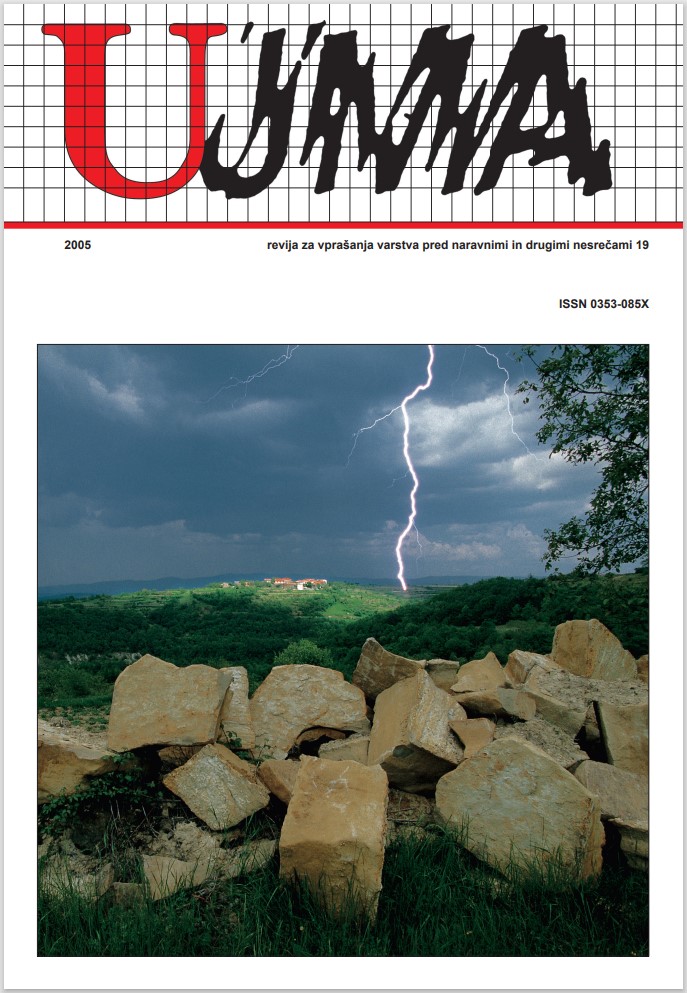EARTHQUAKE OF JULY 12, 2004 IN POSOČJE AND SEISMIC HAZARD MAP - THE INFLUENCE OF SEISMIC RESISTANCE REDUCTION AND RUPTURE DIRECTIVITY
Abstract
In 1976, 1998 and 2004 earthquakes strongly affected the Upper Soča Valley in Slovenia. The magnitude of the earthquake in 2004 was the smallest (4.9) of the four earthquakes (6.5 in May 1976 and 6.0 in September 1976, and 5.6 in 1998). Nevertheless, it causes some striking effects. Some houses, which were apparently undamaged in the previous events, suffered serious damage in the last earthquake. In addition, two accelerometers out of three installed after the 1998 earthquake in the broader epicentral region, registered high peak ground accelerations that considerably exceeded design ground acceleration in the official seismic hazard map for the return period of 475 years. The damage to the aforementioned houses can be simply explained by the assumption that the seismic resistance of those, as well as other houses, was significantly diminished in the previous earthquakes. Analyses of strong motion registration showed that high values can only be partly explained by local soil conditions. The proximity of the seismic source, and especially the rupture directivity, are probably the main causes of the extremely high peak ground accelerations, velocities and spectral values.
References
Adams, J., Atkinson, G. M., 2003. Development of Seismic Hazard Maps for the 2005 National Building Code of Canada, Canadian Journal of Civil Engineering, 30, 255–271.
Adams, J., Halchuk, S., 2004. A review of NBCC 2005 Seismic Hazard Results for Canada – the interface to the ground and prognosis for urban risk mitigation, 57th Canadian Geotehchnical Conference, 5th Joint CGS/IAH-CNC Conference, Session 6C, Québec, 1–8.
ATC – Applied Technology Council, 1978. Tentative provisions for the development of seismic regulations for buildings, ATC 3-06, NBS 510, NSF 78- 8, U.S. Government Printing Office, Washington, str. 514.
Basu, B., Gupta, V. K., 1998. A damage-based definiton of effective peak acceleration, Earthquake Engng & Struct. Dyn. 27, 503–512.
CEN, 1994. Eurocode 8 – Design provisions for earthquake resistance of structures - Part 1-1: General rules - Seismic actions and general requirements for structures, European Prestandard (ENV) 1988-1-1, European Committee for Standardization, str. 25, Brusseles.
CEN, 2004. Eurocode 8 – Design of structures for earthquake resistance, Part 1: General rules, seismic actions and rules for buildings, European standard, EN 1998-1: 2004 (E), Stage 64, European Committee for Standardization, Brussels. (Prevod v slovenščino v pripravi.)
Fajfar, P., Dolšek, P., Fischinger, M., Peruš, I., Poljanšek, K., 2004. Uvajanje standarda Evrokod 8 v Sloveniji, Potresna obtežba, Raziskovalno-razvojna naloga, Univerza v Ljubljani, Fakulteta za gradbeništvo in geodezijo, Inštitut za konstrukcije, potresno inženirstvo in računalništvo.
Frankel, A., Mueller, C., Barnhard, T., Leyendecker, E., Wesson, R., Harmsen, S., Klein, F., Perkins, D., Dickamn, N., Hanson, S. and Hopper, M., 2000. USGS national seismic hazard maps, Earthquake spectra 16, 1–20.
Gosar, A., Živčić, M., Cecič, I., Zupančič, P. , 1999. Seizmološke značilnosti potresa, Ujma 13, 57–65.
Lapajne, J., Šket Motnikar, B., Zupančič, P., 2002. Karta potresne nevarnosti Sloveniji. V: Ušeničnik, A. (urednik), Nesreče in varstvo pred njimi, Uprava RS za zaščito in reševanje Ministrstva za obrambo.
Lapajne, J. K., Šket Motnikar, B., Zabukovec, B., Zupančič, P., 1997. Spatially-smoothed seismicity modelling of seismic hazard in Slovenia, J. Seism. 1, 73–85.
Lapajne, J. K., Zabukovec, B., Zupančič, P., 1996. Trial effective peak ground acceleration map of Slovenia. Reykjavík, XXV General Assembly of the European Seismological Comission, September 9-14, 1996, Abstracts, Islandic Meteorological Office, Ministry for the Environment, University of Iceland, Reykjavík, Island, SC-F1.21.
Sabetta, F., Pugliese, A., Estimation of Response Spectra and Simulation of Nonstationary Earthquake Ground Motions, Bull. Seism. Soc. Am. 86, 337– 352, 1996.
SIS, 2001. Slovenski predstandard Eurocode 8: Projektiranje potresno odpornih konstrukcij, Slovenski institut za standardizacijo, Ljubljana.
Tomaževič, M., 2004. Ob julijskem potresu na Bovškem – potresne sile in poškodbe, Gradbenik 9, 42–45.
Tomaževič, M., Klemenc, I., Lutman, M., 1999. Posledice potresa na kamnitih zidanih hišah: Kaj smo se naučili od potresa, Ujma 13, 122–128.
Tomaževič, M., Lutman, M., Klemenc, I., Weiss, P., 2005. Obnašanje zidanih stavb med potresom v Bovcu 12. 7. 2004, Gradbeni vestnik 54, str. 2–12.
Pravilnik o tehničnih normativih za graditev objektov visoke gradnje na seizmičnih območjih, Uradni list SFRJ, št. 31/1981, str. 844–855.
Pravilnik o spremembah in dopolnitvah Pravilnika o tehničnih normativih za graditev objektov visoke gradnje na seizmičnih območjih, Uradni list SFRJ, št. 52/1990, stran 1729.
URSSM, 2000. Eurocode 8 – Projektiranje potresno odpornih konstrukcij – Del 1-1: Splošna pravila – Potresna obtežba in splošne zahteve za konstrukcije, SIST ENV 1998-1-1, Urad RS za standardizacijo in meroslovje, 2000.
Vidrih, R., 2005. Potres 12. julija 2004 v Zgornjem Posočju, Ujma 19.
Živčić, M., Cecić, I., Gosar, A., Zupančič, P., 1999. Potres 12. aprila 1998 v Zgornjem Posočju – Osnovne značilnosti, 49–64, Potresi v letu 1998.
Downloads
Published
Issue
Section
License

This work is licensed under a Creative Commons Attribution-NonCommercial-NoDerivatives 4.0 International License.
The articles are made available to the public under Creative Commons Attribution-NonCommercial-NoDerivatives 4.0 International (CC BY-NC-ND 4.0).


